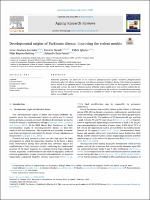Por favor, use este identificador para citar o enlazar este ítem:
https://repositorio.usj.es/handle/123456789/1046
Registro completo de metadatos
| Campo DC | Valor | Lengua/Idioma |
|---|---|---|
| dc.contributor.author | Jiménez-Salvador, Irene | - |
| dc.contributor.author | Meade, Patricia | - |
| dc.contributor.author | Iglesias, Eldris | - |
| dc.contributor.author | Bayona-Bafaluy, Pilar | - |
| dc.contributor.author | Ruiz-Pesini, Eduardo | - |
| dc.date.accessioned | 2024-01-22T11:13:01Z | - |
| dc.date.available | 2024-01-22T11:13:01Z | - |
| dc.date.issued | 2023-02-10 | - |
| dc.identifier.citation | Irene Jiménez-Salvador, Patricia Meade, Eldris Iglesias, Pilar Bayona-Bafaluy, Eduardo Ruiz-Pesini, Developmental origins of Parkinson disease: Improving the rodent models,Ageing Research Reviews, Volume 86, 2023, 101880, ISSN 1568-1637,https://doi.org/10.1016/j.arr.2023.101880. | en_US |
| dc.identifier.issn | 1568-1637 | en_US |
| dc.identifier.uri | https://repositorio.usj.es/handle/123456789/1046 | - |
| dc.description.abstract | Numerous pesticides are inhibitors of the oxidative phosphorylation system. Oxidative phosphorylation dysfunction adversely affects neurogenesis and often accompanies Parkinson disease. Since brain development occurs mainly in the prenatal period, early exposure to pesticides could alter the development of the nervous system and increase the risk of Parkinson disease. Different rodent models have been used to confirm this hypothesis. However, more precise considerations of the selected strain, the xenobiotic, its mode of administration, and the timing of animal analysis, are necessary to resemble the model to the human clinical condition and obtain more reliable results. | en_US |
| dc.format.extent | 8 p. | en_US |
| dc.format.mimetype | application/pdf | en_US |
| dc.language.iso | eng | en_US |
| dc.publisher | Elsevier | en_US |
| dc.relation | I This work was supported by grants from Instituto de Salud Carlos III (ISCIII-FIS-PI21/00229) and European Regional Development Fund (FEDER) ; Gobierno de Aragón (LMP22_21; Grupos Consolidados B33_20R) and FEDER 2014-2020 Construyendo Europa desde Aragon. The CIBERER is an initiative of the ISCIII. Sponsors have not had any role in the study design; in the collection, analysis and interpretation of data; in the writing of the report; and in the decision to submit the article to publication. | en_US |
| dc.rights | Attribution-NonCommercial-NoDerivatives 4.0 Internacional | * |
| dc.rights.uri | http://creativecommons.org/licenses/by-nc-nd/4.0/ | * |
| dc.subject | Parkinson disease | en_US |
| dc.subject | Developmental origins | en_US |
| dc.subject | Pesticide | en_US |
| dc.subject | Oxidative phosphorylation | en_US |
| dc.subject | Rodent model | en_US |
| dc.title | Developmental origins of Parkinson disease: Improving the rodent models | en_US |
| dc.type | journal article | es_ES |
| dc.relation.publisherversion | https://www.sciencedirect.com/science/article/pii/S1568163723000399 | en_US |
| dc.identifier.doi | https://doi.org/10.1016/j.arr.2023.101880 | en_US |
| dc.rights.accessRights | open access | es_ES |
| Aparece en las colecciones: | Artículos de revistas | |
Ficheros en este ítem:
| Fichero | Descripción | Tamaño | Formato | |
|---|---|---|---|---|
| Developmental origins of Parkinson disease.pdf | 562,17 kB | Adobe PDF |  Visualizar/Abrir |
Este ítem está sujeto a una licencia Creative Commons Licencia Creative Commons

